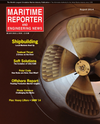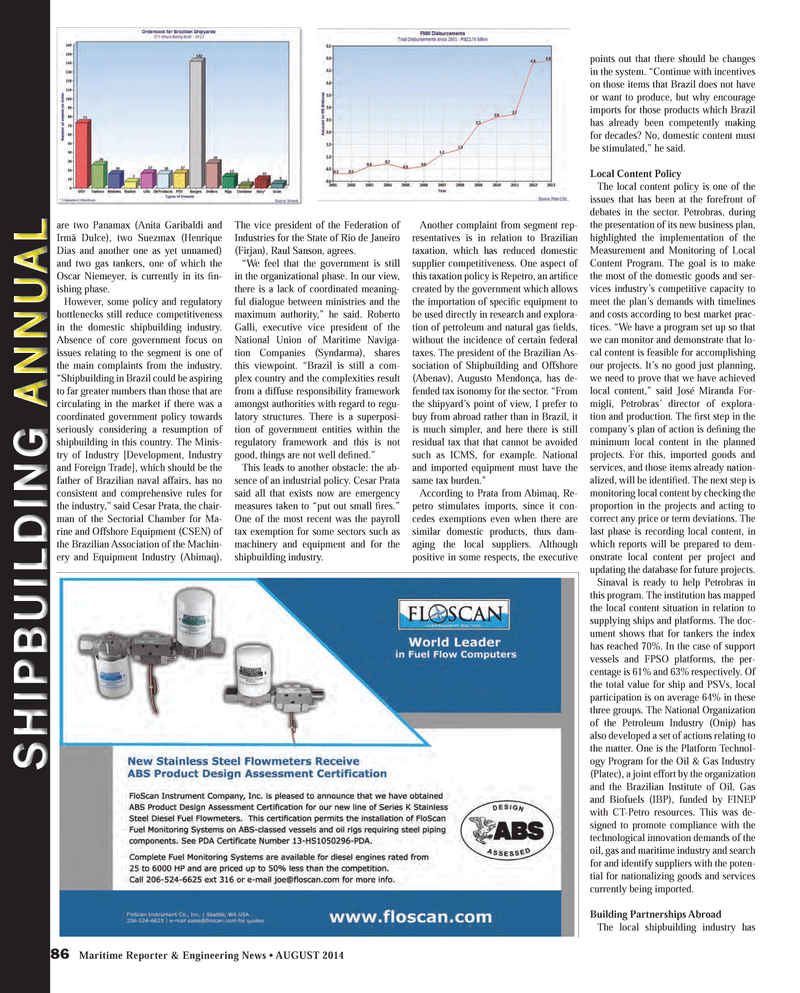
Page 86: of Maritime Reporter Magazine (August 2014)
Shipyard Edition
Read this page in Pdf, Flash or Html5 edition of August 2014 Maritime Reporter Magazine
86 Maritime Reporter & Engineering News ? AUGUST 2014 are two Panamax (Anita Garibaldi and Irmã Dulce), two Suezmax (Henrique Dias and another one as yet unnamed) and two gas tankers, one of which the Oscar Niemeyer, is currently in its Þ n-ishing phase.However, some policy and regulatory bottlenecks still reduce competitiveness in the domestic shipbuilding industry. Absence of core government focus on issues relating to the segment is one of the main complaints from the industry. ?Shipbuilding in Brazil could be aspiring to far greater numbers than those that are circulating in the market if there was a coordinated government policy towards seriously considering a resumption of shipbuilding in this country. The Minis- try of Industry [Development, Industry and Foreign Trade], which should be the father of Brazilian naval affairs, has no consistent and comprehensive rules for the industry,? said Cesar Prata, the chair- man of the Sectorial Chamber for Ma-rine and Offshore Equipment (CSEN) of the Brazilian Association of the Machin- ery and Equipment Industry (Abimaq). The vice president of the Federation of Industries for the State of Rio de Janeiro (Firjan), Raul Sanson, agrees. ?We feel that the government is still in the organizational phase. In our view, there is a lack of coordinated meaning-ful dialogue between ministries and the maximum authority,? he said. Roberto Galli, executive vice president of the National Union of Maritime Naviga-tion Companies (Syndarma), shares this viewpoint. ?Brazil is still a com-plex country and the complexities result from a diffuse responsibility framework amongst authorities with regard to regu-latory structures. There is a superposi- tion of government entities within the regulatory framework and this is not good, things are not well deÞ ned.?This leads to another obstacle: the ab-sence of an industrial policy. Cesar Prata said all that exists now are emergency measures taken to ?put out small Þ res.? One of the most recent was the payroll tax exemption for some sectors such as machinery and equipment and for the shipbuilding industry. Another complaint from segment rep-resentatives is in relation to Brazilian taxation, which has reduced domestic supplier competitiveness. One aspect of this taxation policy is Repetro, an artiÞ ce created by the government which allows the importation of speciÞ c equipment to be used directly in research and explora-tion of petroleum and natural gas Þ elds, without the incidence of certain federal taxes. The president of the Brazilian As- sociation of Shipbuilding and Offshore (Abenav), Augusto Mendonça, has de- fended tax isonomy for the sector. ?From the shipyard?s point of view, I prefer to buy from abroad rather than in Brazil, it is much simpler, and here there is still residual tax that that cannot be avoided such as ICMS, for example. National and imported equipment must have the same tax burden.?According to Prata from Abimaq, Re- petro stimulates imports, since it con-cedes exemptions even when there are similar domestic products, thus dam-aging the local suppliers. Although positive in some respects, the executive points out that there should be changes in the system. ?Continue with incentives on those items that Brazil does not have or want to produce, but why encourage imports for those products which Brazil has already been competently making for decades? No, domestic content must be stimulated,? he said.Local Content Policy The local content policy is one of the issues that has been at the forefront of debates in the sector. Petrobras, during the presentation of its new business plan, highlighted the implementation of the Measurement and Monitoring of Local Content Program. The goal is to make the most of the domestic goods and ser- vices industry?s competitive capacity to meet the plan?s demands with timelines and costs according to best market prac-tices. ?We have a program set up so that we can monitor and demonstrate that lo-cal content is feasible for accomplishing our projects. It?s no good just planning, we need to prove that we have achieved local content,? said José Miranda For- migli, Petrobras? director of explora- tion and production. The Þ rst step in the company?s plan of action is de Þ ning the minimum local content in the planned projects. For this, imported goods and services, and those items already nation-alized, will be identiÞ ed. The next step is monitoring local content by checking the proportion in the projects and acting to correct any price or term deviations. The last phase is recording local content, in which reports will be prepared to dem-onstrate local content per project and updating the database for future projects. Sinaval is ready to help Petrobras in this program. The institution has mapped the local content situation in relation to supplying ships and platforms. The doc- ument shows that for tankers the index has reached 70%. In the case of support vessels and FPSO platforms, the per- centage is 61% and 63% respectively. Of the total value for ship and PSVs, local participation is on average 64% in these three groups. The National Organization of the Petroleum Industry (Onip) has also developed a set of actions relating to the matter. One is the Platform Technol- ogy Program for the Oil & Gas Industry (Platec), a joint effort by the organization and the Brazilian Institute of Oil, Gas and Biofuels (IBP), funded by FINEP with CT-Petro resources. This was de- signed to promote compliance with the technological innovation demands of the oil, gas and maritime industry and search for and identify suppliers with the poten-tial for nationalizing goods and services currently being imported. Building Partnerships Abroad The local shipbuilding industry has MR #8 (82-89).indd 86MR #8 (82-89).indd 868/5/2014 10:05:27 AM8/5/2014 10:05:27 AM

 85
85

 87
87
